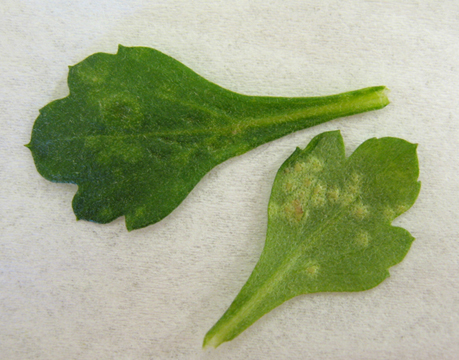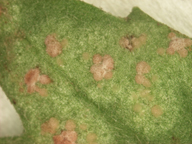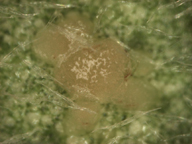Under the Scope Feature
Chrysanthemum White Rust
September-October 2013
Chrysanthemum white rust, caused by the fungus Puccinia horiana is an introduced pest. In the Northeastern US in the fall of 2008, infected plants showed up very quickly and were suspected of coming from one or more sources that shipped plants to nurseries, gardens centers, and box-stores. Plants in nurseries and retail outlets are routinely inspected, and infected plants are destroyed when found. With potted chrysanthemum readily available for sale, now is a good time to keep a lookout for this pest.
White rust spreads through basidiospores by splashing water and can also travel short distances by wind currents during moist weather. Symptoms of white rust appear within 5-14 days of infection as slightly dimpled white to yellow spots up to 4 mm in diameter on the upper surface of a leaf. Over time the spots become brown and buff to pink-colored pustules form on the underside of the leaf below those spots. These pustules become white as the disease progresses, and they may be more common on young leaves and flower bracts although they can be found on any part of the chrysanthemum. These symptoms typically develop during cooler, wet weather; therefore, infected plants may be symptomless during hot and dry periods of weather. The application of fungicide may also suppress symptoms on an infected plant.
The twelve species of chrysanthemum known to be susceptible to white rust include:
· pot mums, spray mums & garden mums (Dendranthema X grandiflorum = Chrysanthemum morifolium)
· Nippon daisy (Nipponicanthemum nipponicum = C. nipponicum)
· High daisy (C. pacificum = Ajania pacifica).
Species that appear to be resistant to white rust include:
· annual chrysanthemum (C. carinatum)
· crown (C. coronarium)
· pyrethrum (Tanacetum coccineum = C. coccineum)
· marguerite daisy (Argyanthemum frutescens)
· ox-eye daisy (Leucanthemum vulgare)
· shasta daisy (Leucanthemum X superbum = C. maximum)
· corn marigold (C. segetum).
CU-PPDC News Feed
Diagnostic review reports and the latest lab updates delivered directly to you. Learn how!




